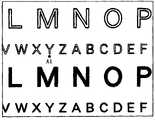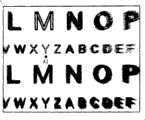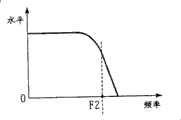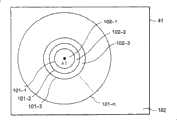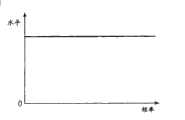CN100440311C - Display control device and method - Google Patents
Display control device and methodDownload PDFInfo
- Publication number
- CN100440311C CN100440311CCNB200510005597XACN200510005597ACN100440311CCN 100440311 CCN100440311 CCN 100440311CCN B200510005597X ACNB200510005597X ACN B200510005597XACN 200510005597 ACN200510005597 ACN 200510005597ACN 100440311 CCN100440311 CCN 100440311C
- Authority
- CN
- China
- Prior art keywords
- image
- user
- viewpoint
- image data
- spatial frequency
- Prior art date
- Legal status (The legal status is an assumption and is not a legal conclusion. Google has not performed a legal analysis and makes no representation as to the accuracy of the status listed.)
- Expired - Fee Related
Links
Images
Classifications
- G—PHYSICS
- G06—COMPUTING OR CALCULATING; COUNTING
- G06F—ELECTRIC DIGITAL DATA PROCESSING
- G06F3/00—Input arrangements for transferring data to be processed into a form capable of being handled by the computer; Output arrangements for transferring data from processing unit to output unit, e.g. interface arrangements
- G06F3/01—Input arrangements or combined input and output arrangements for interaction between user and computer
- G06F3/011—Arrangements for interaction with the human body, e.g. for user immersion in virtual reality
- G06F3/013—Eye tracking input arrangements
- G—PHYSICS
- G06—COMPUTING OR CALCULATING; COUNTING
- G06F—ELECTRIC DIGITAL DATA PROCESSING
- G06F1/00—Details not covered by groups G06F3/00 - G06F13/00 and G06F21/00
- G06F1/16—Constructional details or arrangements
- G06F1/1613—Constructional details or arrangements for portable computers
- G06F1/1626—Constructional details or arrangements for portable computers with a single-body enclosure integrating a flat display, e.g. Personal Digital Assistants [PDAs]
- G—PHYSICS
- G06—COMPUTING OR CALCULATING; COUNTING
- G06F—ELECTRIC DIGITAL DATA PROCESSING
- G06F21/00—Security arrangements for protecting computers, components thereof, programs or data against unauthorised activity
- G06F21/60—Protecting data
- G06F21/62—Protecting access to data via a platform, e.g. using keys or access control rules
- G—PHYSICS
- G09—EDUCATION; CRYPTOGRAPHY; DISPLAY; ADVERTISING; SEALS
- G09G—ARRANGEMENTS OR CIRCUITS FOR CONTROL OF INDICATING DEVICES USING STATIC MEANS TO PRESENT VARIABLE INFORMATION
- G09G5/00—Control arrangements or circuits for visual indicators common to cathode-ray tube indicators and other visual indicators
- G—PHYSICS
- G09—EDUCATION; CRYPTOGRAPHY; DISPLAY; ADVERTISING; SEALS
- G09G—ARRANGEMENTS OR CIRCUITS FOR CONTROL OF INDICATING DEVICES USING STATIC MEANS TO PRESENT VARIABLE INFORMATION
- G09G5/00—Control arrangements or circuits for visual indicators common to cathode-ray tube indicators and other visual indicators
- G09G5/36—Control arrangements or circuits for visual indicators common to cathode-ray tube indicators and other visual indicators characterised by the display of a graphic pattern, e.g. using an all-points-addressable [APA] memory
- G09G5/37—Details of the operation on graphic patterns
- G—PHYSICS
- G09—EDUCATION; CRYPTOGRAPHY; DISPLAY; ADVERTISING; SEALS
- G09G—ARRANGEMENTS OR CIRCUITS FOR CONTROL OF INDICATING DEVICES USING STATIC MEANS TO PRESENT VARIABLE INFORMATION
- G09G2340/00—Aspects of display data processing
- G09G2340/14—Solving problems related to the presentation of information to be displayed
- G—PHYSICS
- G09—EDUCATION; CRYPTOGRAPHY; DISPLAY; ADVERTISING; SEALS
- G09G—ARRANGEMENTS OR CIRCUITS FOR CONTROL OF INDICATING DEVICES USING STATIC MEANS TO PRESENT VARIABLE INFORMATION
- G09G2354/00—Aspects of interface with display user
- G—PHYSICS
- G09—EDUCATION; CRYPTOGRAPHY; DISPLAY; ADVERTISING; SEALS
- G09G—ARRANGEMENTS OR CIRCUITS FOR CONTROL OF INDICATING DEVICES USING STATIC MEANS TO PRESENT VARIABLE INFORMATION
- G09G2358/00—Arrangements for display data security
Landscapes
- Engineering & Computer Science (AREA)
- Theoretical Computer Science (AREA)
- Physics & Mathematics (AREA)
- General Physics & Mathematics (AREA)
- General Engineering & Computer Science (AREA)
- Computer Hardware Design (AREA)
- Human Computer Interaction (AREA)
- Bioethics (AREA)
- Health & Medical Sciences (AREA)
- General Health & Medical Sciences (AREA)
- Computer Security & Cryptography (AREA)
- Software Systems (AREA)
- Image Processing (AREA)
- User Interface Of Digital Computer (AREA)
- Image Analysis (AREA)
- Controls And Circuits For Display Device (AREA)
Abstract
Description
Translated fromChinese本申请要求于2004年1月21日向日本专利局提交的日本优先权文件第2004-012577号的优先权,这里引用其内容以资参考。This application claims priority from Japanese Priority Document No. 2004-012577 filed with the Japan Patent Office on January 21, 2004, the contents of which are incorporated herein by reference.
技术领域technical field
本发明涉及显示控制装置及方法、记录介质、以及程序,更具体地说,涉及能够控制图像的清晰度的显示控制装置及方法、记录介质、以及程序。The present invention relates to a display control device and method, a recording medium, and a program, and more specifically, to a display control device and method, a recording medium, and a program capable of controlling the sharpness of an image.
背景技术Background technique
近来,诸如移动电话、个人数字助理(PDA)、电子纸张等具有特定用户并在公共场合被操作的便携式信息处理装置已经逐渐普及。Recently, portable information processing devices, such as mobile phones, personal digital assistants (PDAs), electronic papers, etc., which have a specific user and are operated in public places, have become popular.
并且,已经研发出了头部安装(head amounted)显示器,其中头部安装显示器通过检测用户视线的方向来检测用户正在观看的观察目标的方向以及观察目标的位置(如专利文件1)。Also, a head mounted display has been developed, wherein the head mounted display detects the direction of an observation target that the user is looking at and the position of the observation target by detecting the direction of the user's line of sight (eg, Patent Document 1).
并且,已经研发出了另一种图像处理系统,即,其中图像处理系统控制由戴在人体上的照相机拾取的图像的显示、根据人的移动来校正拍摄的目标图像的抖动、或者进行场景变换(如专利文件2)。Also, another image processing system has been developed in which the image processing system controls display of an image picked up by a camera worn on a human body, corrects shake of a captured target image according to movement of a person, or performs scene change (such as patent document 2).
专利文件1:日本专利待审公开第2001-34408号Patent Document 1: Japanese Patent Unexamined Publication No. 2001-34408
专利文件2:日本专利待审公开第2003-19886号Patent Document 2: Japanese Patent Unexamined Publication No. 2003-19886
发明内容Contents of the invention
但是,这些便携式信息处理装置存在问题,即,当提高显示装置的清晰度时,所显示的内容容易被并非用户的第三人看到,反之,当为了防止第三人容易地看到图像内容而减小显示装置的视角时,显示装置的清晰度被降低而使用户难以识别所显示的内容。However, these portable information processing devices have a problem that when the clarity of the display device is improved, the displayed content is easily seen by a third person other than the user, and conversely, when the image content is prevented from being easily seen by a third person When the viewing angle of the display device is reduced, the definition of the display device is reduced, making it difficult for the user to recognize the displayed content.
并且,专利文件1和专利文件2中描述的发明没有公开所显示的图像的的清晰度的控制,并且未能解决所述问题。Also, the inventions described in
因此,针对这种情况提出本发明,它能够基于用户视点来控制图像的清晰度。Therefore, the present invention is proposed for this situation, which can control the sharpness of the image based on the user's point of view.
本发明的显示控制装置包括:检测部分,用于检测显示装置的屏幕上的用户视点;以及控制部分,用于控制图像显示,以便抑制由检测部分检测到的用户视点周围的图像的空间频率中的成分。The display control device of the present invention includes: a detection section for detecting a user's point of view on the screen of the display device; and a control section for controlling image display so as to suppress the spatial frequency of the image around the user's point of view detected by the detection section. ingredients.
所述控制部分可以控制图像显示,以便基于像素与用户视点之间的距离来抑制图像像素的高空间频率中的成分。The control section may control image display so as to suppress a component in a high spatial frequency of an image pixel based on a distance between the pixel and a user's viewpoint.
所述显示控制装置还可以包括用于清除图像像素的高空间频率中的成分的滤波器,并且,所述控制部分可以控制图像显示以便通过在滤波器的多个输出中选择一个输出来抑制用户视点周围的图像的空间频率中的成分。The display control means may further include a filter for removing components in high spatial frequencies of the image pixels, and the control section may control the image display so as to suppress the user by selecting one of outputs of the filter. The component in the spatial frequency of the image around the viewpoint.
所述显示控制装置还可以包括用于获取通过对用户成像而得到的图像数据的获取部分,并且,所述检测部分可以基于由获取部分取得的图像数据来检测用户视点。The display control device may further include an acquisition section for acquiring image data obtained by imaging the user, and the detection section may detect the user viewpoint based on the image data acquired by the acquisition section.
本发明的显示控制方法包括:检测步骤,用于检测显示装置的屏幕上的用户视点;以及控制步骤,用于控制图像显示以便抑制通过检测步骤的处理检测出的用户视点周围的图像的空间频率中的成分。The display control method of the present invention includes: a detection step for detecting a user's point of view on a screen of a display device; and a control step for controlling image display so as to suppress a spatial frequency of an image around the user's point of view detected by the processing of the detection step ingredients in.
本发明的记录介质上所记录的程序包括:检测步骤,用于检测显示装置的屏幕上的用户视点;以及控制步骤,用于控制图像显示以便抑制通过检测步骤的处理检测出的用户视点周围图像的空间频率中的成分。The program recorded on the recording medium of the present invention includes: a detection step for detecting a user's point of view on a screen of a display device; and a control step for controlling image display so as to suppress images around the user's point of view detected by the processing of the detection step components in the spatial frequency of .
本发明的程序包括:检测步骤,用于检测显示装置的屏幕上的用户视点;以及控制步骤,用于控制图像显示以便抑制通过检测步骤的处理检测出的用户视点周围图像的空间频率中的成分。The program of the present invention includes: a detection step for detecting a user's point of view on a screen of a display device; and a control step for controlling image display so as to suppress a component in a spatial frequency of an image around the user's point of view detected by the processing of the detection step .
在所述本发明的显示控制装置、显示控制方法、记录介质上所记录的程序、以及程序中,检测显示装置的屏幕上的用户视点、并控制图像显示以便抑制检测出的用户视点周围图像的空间频率的成分。In the display control device, the display control method, the program recorded on the recording medium, and the program of the present invention, the user's point of view on the screen of the display device is detected, and image display is controlled so as to suppress blurring of images around the detected user's point of view. components of the spatial frequency.
如上所述,根据本发明,可以控制显示图像的清晰度。而且,根据本发明,在确保用户能够识别所显示内容的同时,能使并非使用者的第三人难以容易地看到所显示的内容。As described above, according to the present invention, the sharpness of a displayed image can be controlled. Furthermore, according to the present invention, while ensuring that the user can recognize the displayed content, it is possible to make it difficult for a third person who is not the user to easily see the displayed content.
附图说明Description of drawings
图1是示出应用本发明的图像显示系统的构造的实施例的视图;FIG. 1 is a view showing an embodiment of the configuration of an image display system to which the present invention is applied;
图2是示出输入图像显示系统的图像的实施例的视图;FIG. 2 is a view showing an example of an image input to an image display system;
图3是示出显示装置的屏幕上的用户视点位置的视图;FIG. 3 is a view showing a position of a user's point of view on a screen of a display device;
图4是示出要在显示装置上显示的屏幕的实施例的视图;FIG. 4 is a view showing an example of a screen to be displayed on a display device;
图5是示出显示装置的坐标系的视图;FIG. 5 is a view showing a coordinate system of a display device;
图6是示出显示控制单元的构造的实施例的视图;FIG. 6 is a view showing an example of a configuration of a display control unit;
图7是示出滤波器的频率特性的实施例的视图;FIG. 7 is a view showing an example of frequency characteristics of a filter;
图8是示出滤波器的频率特性的实施例的视图;FIG. 8 is a view showing an example of frequency characteristics of a filter;
图9是示出滤波器的频率特性的实施例的视图;FIG. 9 is a view showing an example of frequency characteristics of a filter;
图10是示出滤波器的频率特性的实施例的视图;FIG. 10 is a view showing an example of frequency characteristics of a filter;
图11是图解说明图像显示系统中的视点检测处理的流程图;11 is a flowchart illustrating viewpoint detection processing in the image display system;
图12是图解说明图像显示系统中的图像显示处理的流程图;12 is a flowchart illustrating image display processing in the image display system;
图13是示出显示装置的屏幕的区域划分的实施例的视图;FIG. 13 is a view illustrating an example of area division of a screen of a display device;
图14是图解说明图像数据的频率特性的实施例的视图;FIG. 14 is a view illustrating an example of frequency characteristics of image data;
图15是示出显示装置的屏幕上的视点的位置的视图;FIG. 15 is a view showing positions of viewpoints on a screen of a display device;
图16是示出要在显示装置显示的屏幕的实施例的视图;FIG. 16 is a view showing an example of a screen to be displayed on a display device;
图17是图解说明图像显示系统中的图像显示处理的流程图;以及FIG. 17 is a flowchart illustrating image display processing in the image display system; and
图18是示出个人电脑的构造的实施例的框图。FIG. 18 is a block diagram showing an example of the configuration of a personal computer.
具体实施方式Detailed ways
下面将描述本发明的实施例。本发明与本说明书中所述的各实施例之间的对应关系举例说明如下。对于本说明,即使存在本说明书中描述了但并未作为与本发明对应的实施例来描述的实施例,这样的说明也并不意味着该实施例不对应于本发明。反之,即使作为与发明对应的实施例来描述的实施例,这样的说明也不意味着该实施例不对应于本发明而对应于在先发明。Embodiments of the present invention will be described below. The correspondence relationship between the present invention and each embodiment described in this specification is exemplified as follows. With this description, even if there is an embodiment described in this specification but not described as an embodiment corresponding to the present invention, such description does not mean that the embodiment does not correspond to the present invention. Conversely, even if an embodiment is described as an embodiment corresponding to the invention, such a description does not mean that the embodiment does not correspond to the present invention but corresponds to a prior invention.
而且,该说明也不意味着本说明书中所描述的所有发明都要求得到专利权的保护。换言之,该说明不否认存在有本说明书中描述了但本申请却未要求保护的发明,即,不否认存在有将来会作为分案申请而提交、或者会通过修改而公布、或者会被加入本权利要求书的发明。Furthermore, this description does not imply that all inventions described in this specification are claimed to be protected by patent rights. In other words, the statement does not deny the existence of inventions described in this specification but not claimed in this application, that is, it does not deny the existence of inventions that will be filed as divisional applications in the future, or will be published by amendment, or will be added to this application. Claimed invention.
根据本发明,提供一种显示控制装置。该显示控制装置(如图1中的显示控制装置12)包括:检测部分(如图1中的视点检测单元22),用于检测显示装置(如图1中的显示装置13)的屏幕上的用户视点;以及控制部分(如图1中的图像处理单元23),用于控制图像显示,以便抑制由检测部分检测到的用户视点周围的图像的空间频率中的成分。According to the present invention, a display control device is provided. The display control device (such as the
所述显示控制装置(如图1中的显示控制装置12)还包括用于清除图像像素的高空间频率的成分的滤波器(如图6中的滤波器52-1至52-n),并且,所述控制部分可以控制图像显示以便通过在滤波器的多个输出中选择一个输出来抑制用户视点周围的图像的空间频率中的成分。The display control device (such as the
所述显示控制装置(如图1中的显示控制装置12)还包括用于取得通过对用户成像而获取的图像数据(如用户图像数据)的获取部分(如图1中的输入单元21),并且,所述检测部分可以基于由获取部分获取的图像数据来检测用户视点。The display control device (such as the
根据本发明,提供了一种显示控制方法。该显示控制方法包括:检测步骤(如图11中的步骤S3),用于检测显示装置(如图1中的显示装置13)的屏幕上的用户视点;以及控制步骤(如图12中的步骤S23至S27),用于控制图像显示以便抑制通过检测步骤的处理检测出的用户视点周围图像的空间频率中的成分。According to the present invention, a display control method is provided. The display control method includes: a detection step (such as step S3 in FIG. 11 ), which is used to detect the user viewpoint on the screen of a display device (such as the
根据本发明,提供一种程序。该程序包括:检测步骤(如图11中的步骤S3),用于检测显示装置(如图1中的显示装置13)的屏幕上的用户视点;以及控制步骤(如图12中的步骤S23至S27),用于控制图像显示以便抑制通过检测步骤的处理检测出的用户视点周围图像的空间频率中的成分。According to the present invention, a program is provided. The program includes: a detection step (such as step S3 in Figure 11) for detecting the user's point of view on the screen of a display device (such as the
所述程序可以被记录在记录介质(如图18中的可移动介质521)中。The program may be recorded in a recording medium such as the
以下,参照附图描述本发明的实施例。Hereinafter, embodiments of the present invention are described with reference to the drawings.
图1是示出应用本发明的图像显示系统1的基本构造的实施例的框图。图像显示系统1由照相机11、显示控制装置12、和显示装置13组成。FIG. 1 is a block diagram showing an embodiment of the basic configuration of an
照相机11设置在显示装置13附近,其不断拍摄正在使用图像显示系统1的用户2,以便向显示控制装置12输出所拍摄的数据(以下称作用户图像数据)。The
显示控制装置12基于从照相机11获得的用户图像数据来检测用户2注视在显示装置13的屏幕上的位置,即,用户视点。显示控制装置12基于检测出的用户2的视点,从输入图像数据(以下称作输入图像数据)生成其清晰度受到控制的图像数据(以下称作输出图像数据),并将所产生的输出图像数据输出给显示装置13。The
人类具有视觉特性使其能识别作为中心(中间视野)的视线附近位置上的图像的微小变化,但却不能识别远离视线的位置上的图像的微小变化。也就是说,人类能够识别的空间频带在中间视野内是最宽的,并且位于某位置上的空间频带的高频成分会随着所述位置变得远离视线而降低。因此,空间频带随着所述位置变得远离视线而变窄。Humans have visual characteristics such that they can recognize small changes in images at positions near the line of sight as the center (middle field of vision), but cannot recognize small changes in images at positions far from the line of sight. That is, the spatial frequency band that humans can recognize is the widest in the middle field of view, and the high-frequency components of the spatial frequency band located at a certain position decrease as the position becomes farther from the line of sight. Therefore, the spatial frequency band narrows as the position becomes farther away from the line of sight.
例如,在图2所示的图像被输入显示控制装置12中且图像被显示在显示装置13上的情况下,当用户视点的中心转移到图3中的点A1时,显示控制装置12利用人类的视觉特性进行控制以便显示图像,其中点A1附近的图像的空间频率成分保持不变,并且,如图4所示,当图像的位置变得更加远离点A1时,图像的高空间频率成分被更加抑制。即,在显示装置13上显示的图像中,用户视点中心附近的图像部分被正常显示,图像的微小变化(其区别随着所述变化逐渐远离用户视点中心而使用户2更加难以识别)被从图像中清除。For example, in the case where the image shown in FIG. 2 is input into the
显示装置13基于从显示控制装置12获得的输出图像数据而显示图像。The
显示控制装置12由输入单元21、视点检测单元22、图像处理单元23、输入单元24和输出单元25组成。The
视点检测单元22基于通过输入单元21从照相机11得到的用户图像数据来获取图5所示的显示装置13的屏幕41上的用户2的视点V的中心的坐标(以下称为视点坐标),后面会参照图11对此进行描述。取屏幕41的左上角为屏幕41的坐标系的原点,取水平向右为x轴方向,并取垂直向下为y轴方向,以此表示屏幕41的坐标系。视点检测单元22将检测出的视点坐标发送至图像处理单元23。The
图像处理单元23通过输入单元24获取输入图像数据。图像处理单元23通过输出单元25向显示装置13输出通过基于从视点检测单元22发送的视点坐标对输入图像数据的空间频率成分进行控制而得到的输出图像数据,后面会参照图12对此进行描述。The
图6是示出图像处理单元23的基本构造的实施例的框图。图像处理单元23由输入数据处理单元51、滤波器52-1至52-n(以下,当无须表示出是52-1至52-n中的具体哪一个时,简称为滤波器52)、距离计算单元53、选择器54和图像数据产生单元55组成。FIG. 6 is a block diagram showing an example of the basic configuration of the
输入数据处理单元51通过输入单元24获取输入图像数据。输入数据处理单元51按次序指定输入图像数据中的每个像素作为图像处理点,该点成为空间频率成分的滤波对象。输入数据处理单元51向选择器54提供被指定为图像处理点的像素的图像数据,并将作为中心的图像处理点周围的预定区域中的像素的图像数据提供给滤波器52。输入数据处理单元51将屏幕41上的指定的图像处理点的坐标发送至距离计算单元53。The input
滤波器52抑制等于或大于从输入数据处理单元51获取的图像处理点的图像数据的预定截止频率的空间频率的空间频率成分,并将被抑制的空间频率成分提供给选择器54。The
滤波器52是彼此具有不同截止频率的滤波器。以下的描述是在如下假定的前提下进行的:滤波器52-1的频率特性如图7中的图表所示,滤波器52-2的频率特性如图8中的图表所示,滤波器52-3的频率特性如图9中的图表所示,而滤波器52-n的频率特性如图10中的图表所示。如图7-10所示,滤波器52-1、52-2、52-3的截止频率F1、F2和F3依次降低,而在全部滤波器52当中滤波器52-n的截止频率Fn是最低的。The
如图7-10的频率特性中所示,空间频率成分由滤波器52从稍低于图像数据的截止频率的频率开始削弱,并从图像数据中清除几乎所有的频率高于截止频率的空间频率成分。As shown in the frequency characteristics of FIGS. 7-10, the spatial frequency components are attenuated by the
例如,滤波器52被制成空间滤波器,当图像数据位于图像处理点时,滤波器输出通过使作为中心(滤波器尺寸)的图像处理点周围的预定区域内的各像素的图像数据乘以预定系数、以及通过将所乘的图像数据彼此相加(通过进行图像数据的卷积积分)而得到的数据。由此,等于或大于截止频率的频率的空间频率成分被抑制,该空间频率成分包含在位于图像处理点上的图像数据中。空间滤波器的截止频率根据滤波器尺寸的大小,即,卷积积分的对象的面积的大小(卷积积分的对象的像素的数目)和系数而被调整。For example, the
距离计算单元53从检测单元22获取视点坐标,并从输入数据处理单元51获取位于图像处理点处的坐标。然后,距离计算单元53获取图像处理点与视点坐标之间的距离(以下称作距图像处理点的距离),以便将所获取的距图像处理点的距离传给选择器54。The
选择器54选择由输入数据处理单元51直接提供的图像数据与其高空间频率成分被滤波器52基于从距离计算单元53输出的距图像处理点的距离而抑制(或清除)的图像数据之间的一块图像数据,并将所选择的图像数据提供给图像数据产生单元55。The
图像数据产生单元55从由选择器54提供的各像素的图像数据产生一帧的输出图像数据,并通过输出单元25将所产生的图像数据输出给显示装置13。The image
下面,将参照图11-16描述由图像显示系统1执行的处理。Next, processing performed by the
首先,参照图11所示的流程,描述由图像显示系统1执行的视点检测处理。顺便提及,当用户2命令处理开始时,开始进行处理,当用户2命令处理停止时,停止处理。First, viewpoint detection processing performed by the
在步骤S1,视点检测单元22通过输入单元21获取由照相机11拍摄的用户图像数据。In step S1 , the
在步骤S2,视点检测单元22基于用户图像数据来检测用户2的视线的方向。例如,视点检测单元22基于用户图像数据来检测用户2双眼的轮廓、双眼两端的位置、以及鼻孔的位置。视点检测单元22基于双眼两端的位置和鼻孔的位置来估计眼球的中心位置和半径,并基于用户2的眼睛的轮廓中的亮度信息来检测瞳孔的中心位置。视点检测单元22作出连接眼球中心和瞳孔中心的矢量,并将所得到的矢量的方向设定为用户2的视线的方向。In step S2 , the
在步骤S3,视点检测单元22基于由步骤S2中的处理检测出的用户2的视线的方向来检测用户2正在观看的视点在显示装置13的屏幕41上的视点视点检测单元22将位于检测出的视点的中心处的像素的坐标设定为视点坐标。然后,处理返回步骤S1,重复步骤S1至S3的处理。In step S3, the
下面参照图12的流程,描述图像显示系统1所执行的图像显示处理。顺便提及,当用户2命令处理开始时,开始进行处理,当用户2命令处理停止时,停止处理。The image display processing performed by the
在步骤S21,输入数据处理单元51通过输入单元24获取输入图像数据。后面的描述在如下假定的前提下进行:图2中所示的图像的输入图像数据是在步骤S21中获取的。In step S21 , the input
在步骤S22,距离计算单元53从视点检测单元22获取在图11中的步骤S3的处理所得到的视点坐标。后面的描述在如下假定的前提下进行:图3中所示的点A1的坐标是在步骤S22中作为视点坐标得到的。In step S22 , the
在步骤S23,输入数据处理单元51指定输入图像数据中的一个像素作为图像处理点。例如,图像处理点的像素按照光栅扫描的顺序来指定。In step S23, the input
在步骤S24,对在图像处理点处的图像数据进行滤波处理。更具体地说,输入数据处理单元51将作为中心的图像处理点周围的预定区域中的图像数据提供给滤波器52。滤波器52抑制其频率等于或大于截止频率的频率的空间频率成分,该空间频率成分包含在图像处理点的图像数据中,并且滤波器52将所抑制的图像数据提供给选择器54。而且,输入数据处理单元51直接向选择器54提供图像处理点处的图像数据,即,具有作为原始输入图像数据的未受处理的空间频率成分的图像数据。因此,由具有作为原始输入图像数据的空间频率成分的图像数据、以及具有包含已经由滤波器52-1至52-n抑制的等于或大于截止频率F1至Fn中任一个的频率的被抑制部分的空间频率成分的图像数据组成的n+1种图像数据作为图像处理点处的图像数据被提供给选择器54。In step S24, filter processing is performed on the image data at the image processing point. More specifically, the input
在步骤S25,距离计算单元53从输入数据处理单元51获取图像处理点处的坐标,并计算距图像处理点的距离z,以便将计算出的距离z传给选择器54。当假设作为视点坐标的点A1的坐标是(vx,vy)以及图像处理点的坐标是(x,y)时,可由如下公式(1)得出距图像处理点的距离z。In step S25 , the
在步骤S26,选择器54基于由距离计算单元53传递的距图像处理点的距离z,选择,从由输入数据处理单元51提供的图像数据和由滤波器52-1至52-n在步骤S24提供的图像数据之间的一块图像数据,并将所选择的图像数据提供给图像数据产生单元55作为图像处理点处的图像数据。In step S26, the
例如,如图13中所示,选择器54通过同心圆101-1至101-n将屏幕41分成区域102-1至102-n+1的n+1个区域,所述同心圆具有作为用户视点2的中心的中心点A1(视点坐标)且彼此具有不同的半径。当同心圆101-1至101-n的半径分别表示为半径z1至zn时,半径z1至zn的大小关系按如下公式(2)表示。For example, as shown in FIG. 13 , the
0<z1<z2<z3<...<zn......(2)0<z1<z2<z3<...<zn...(2)
屏幕41分成多个区域,使得在同心圆101-1内部中的区域是区域102-1,位于同心圆101-1与同心圆101-2之间的区域是区域102-2,位于同心圆101-2与同心圆101-3之间的区域是区域102-3,而在同心圆101-n外部的区域假设为区域102-n+1。The
在0≤z<z1的情况下,即,在图像处理点包含在区域102-1中的情况下,选择器54基于距图像处理点的距离z直接将图像数据从输入数据处理单元51提供给图像数据产生单元55。也就是说,包含在含有作为视点坐标的点A1的区域102-1中的像素的图像数据的空间频率成分不会如图14的频率特性所示那样被改变。In the case of 0≦z<z1, that is, in the case where the image processing point is included in the area 102-1, the
在z1≤z<z2的情况下,即,在图像处理点包含在区域102-2中的情况下,选择器54将图像数据从滤波器52-1提供给图像数据产生单元55。如果z2≤z<z3,即,如果图像处理点包含在区域102-3中,选择器54将从滤波器52-2提供的图像数据提供给图像数据产生单元55。之后,选择器54基于距图像处理点的距离z来类似地选择要被提供给图像数据产生单元55的图像数据,并将所选择的数据提供给图像数据产生部分55。如果z≥zn,即,如果图像处理点包含在区域102-n+1中,选择器54将从滤波器52-n提供的图像数据提供给图像数据产生单元55。In the case of z1≦z<z2, that is, in the case where the image processing point is contained in the area 102-2, the
也就是说,随着像素变得渐渐远离作为视点坐标的点A1,图像数据的高空间频率成分基于如图7-1所示的各滤波器52的频率特性借助于较低截止频率而被抑制。That is, as the pixel becomes gradually farther from the point A1 as the viewpoint coordinates, the high spatial frequency components of the image data are suppressed by means of a lower cutoff frequency based on the frequency characteristic of each
顺便提及,如果在步骤S22没有获取视点坐标,选择器54在步骤S26将从滤波器52-n提供的图像数据提供给图像数据产生部分55。因此,当用户2未看着屏幕41时,比整个图像的最低截止频率Fn高的图像数据的空间频率成分被抑制。Incidentally, if the viewpoint coordinates are not acquired at step S22, the
而且,当在步骤S22未得到视点坐标时,选择器54可以在步骤S26将从输入数据处理单元51提供的图像数据不经过滤波器52而提供给图像数据产生单元55。在这种情况下,输入图像按照原样显示在显示装置13上。Also, when the viewpoint coordinates are not obtained at step S22, the
在步骤S27,输入数据处理单元51判断输入图像数据中的所有像素是否都已经被处理过。如果判断出输入图像数据中的所有像素并非都被处理过,程序返回步骤S23。步骤S23至S27中的处理被重复,直到在步骤S27判断出输入图像数据中的所有像素都已经被处理过。也就是说,输入图像数据中的所有像素的空间频率成分都根据作为位于用户视点2中心的点A1与各像素之间的距离被抑制。In step S27, the input
如果在步骤S27判断出所有像素都已经被处理过,则处理进行至步骤S28。在步骤S28,图像数据产生单元55根据从选择器54提供的所有像素的图像数据而产生一帧的输出图像数据。If it is determined in step S27 that all pixels have been processed, the process proceeds to step S28. In step S28 , the image
在步骤S29,图像数据产生单元55通过输出单元25向显示装置13输出输出图像数据。显示装置13基于输出图像数据而显示图像。也就是说,如图4所示,使位于作为用户视点中心的点A1附近的图像的清晰度原样成为输入图像,而具有大幅降低的清晰度的图像显示在其位置远离点A1的区域中从而使用户2难以区别图像的微小变化。In step S29 , the image
之后,处理返回至步骤S21,并且重复步骤S21至S29的处理,根据用户视点2的移动来控制要显示在显示装置13上的图像的空间频率成分。例如,如果用户视点2的中心已经从图4中的点A1移至图15中的点A2,如图16中所示的作为中心的点A2周围的图像的高空间频率就被抑制,从而控制图像的清晰度。Thereafter, the process returns to step S21, and the processes of steps S21 to S29 are repeated to control the spatial frequency components of the image to be displayed on the
在上述方法中,通过根据用户视点2来抑制输入图像的高空间频率成分而得到的图像被显示,从而对于非用户2的第三人的图像的清晰度降低而不会降低对于用户2的图像的清晰度。因此,能够使非用户2的第三人不能容易地看到图像的内容。也就是说,用户2可以自然地观看或辨别所显示图像的内容。另一方面,对于视点与用户2不同的第三人来说,除了位于图像的高空间频率成分未被抑制的、用户视点2的中心附近的区域外,图像的清晰度变差,并且非用户2的第三人变得不能识别图像的内容。In the above method, an image obtained by suppressing the high spatial frequency components of the input image according to the user's viewpoint 2 is displayed so that the sharpness of the image for a third person other than the user 2 is reduced without degrading the image for the user 2 clarity. Therefore, it is possible to prevent a third person other than the user 2 from easily viewing the content of the image. That is, the user 2 can naturally watch or recognize the content of the displayed image. On the other hand, for a third person whose viewpoint is different from that of user 2, the sharpness of the image deteriorates except for an area near the center of user viewpoint 2 where the high spatial frequency components of the image are not suppressed, and the non-user 2 The third person becomes unable to recognize the content of the image.
而且,包含在图像内的高空间频率成分被抑制,因而除了用户视点2的中心附近的区域外,不显示具有高清晰度的图像。另外,所显示的图像随着用户视点2的移动而改变。因此,可以缓解由诸如等离子显示板(PDP)等的显示装置13的屏幕41的发热产生引起的老化损坏,所述显示装置13由具有固定像素的显示装置制成。Also, high spatial frequency components contained in the image are suppressed, so that an image with high definition is not displayed except for an area near the center of the user's viewpoint 2 . In addition, the displayed image changes as the user's point of view 2 moves. Therefore, aging damage caused by heat generation of the
在以这样一种方式检测显示装置的屏幕上的用户视点并根据检测出的用户视点来控制所显示的图像的清晰度的情况下,可使第三人不能容易地看到所显示的内容同时保证用户能识别所显示的内容。In the case of detecting the user's point of view on the screen of the display device in such a manner and controlling the sharpness of the displayed image according to the detected user's point of view, the displayed content can be prevented from being easily seen by a third person while Ensure that users can recognize the displayed content.
顺便提及,在应用本发明的图像显示系统1的上述实施例中,示出了这样一个示例:在一个帧的图像数据的每个处理中得到视点坐标,并在视点坐标固定的情况下进行一个帧的图像数据的图像显示处理。但是,也可以在执行图像显示处理的同时,根据用户的视线的方向不断改变视点坐标,即使是在同一帧中也不固定视点坐标。以下,参照图17的流程图,描述不断改变视点坐标的情况下的图像显示处理。Incidentally, in the above-described embodiment of the
如同通过对比图12和17的流程清楚看出的那样,在一个帧的图像数据的处理期间固定视点坐标的情况下的图像显示处理(图12)的基础处理与在一个帧的图像数据的处理期间改变视点坐标的情况下的基础处理(图17)彼此相似。As is clear by comparing the flows of FIGS. 12 and 17, the basic processing of the image display processing (FIG. 12) in the case of fixing the viewpoint coordinates during the processing of the image data of one frame is different from the processing of the image data of one frame. The basic processing ( FIG. 17 ) in the case of changing the coordinates of the viewpoint during the period is similar to each other.
但是,在视点坐标被改变的情况下,与视点坐标被固定的情况不同的是,当在与图12中的步骤S27对应的步骤S127的处理中判断出并非输入图像数据中的所有像素都已经被处理过时,处理不返回与步骤S23对应的步骤S123,而是返回与步骤S22对应的步骤S122,并重复步骤S122至S127的处理,直到在步骤S127判断出输入图像数据中的所有像素都已经被处理过。也就是说,在每次完成输入图像数据中的一个像素的处理时得到一对视点坐标,并根据得到的视点坐标来抑制被指定为图像处理点的像素的图像数据的高空间频率成分。However, in the case where the viewpoint coordinates are changed, unlike the case where the viewpoint coordinates are fixed, when it is judged in the processing of step S127 corresponding to step S27 in FIG. 12 that not all pixels in the input image data have been When processed, the processing does not return to step S123 corresponding to step S23, but returns to step S122 corresponding to step S22, and repeats the processing of steps S122 to S127 until it is judged in step S127 that all pixels in the input image data have been been processed. That is, a pair of viewpoint coordinates is obtained every time processing of one pixel in input image data is completed, and high spatial frequency components of image data of pixels designated as image processing points are suppressed based on the obtained viewpoint coordinates.
因此,更严格地基于用户视点2的移动来控制显示装置13上显示的图像的空间频率成分。Therefore, the spatial frequency components of the image displayed on the
而且,可以应用以红外线照射用户以进行使用红外线图像的检测的技术或者不同脸部图像识别技术作为检测用户视线的方向的方法。Also, a technique of irradiating a user with infrared rays to perform detection using an infrared image or a different face image recognition technique may be applied as a method of detecting the direction of the user's line of sight.
而且,可以通过如下过程来抑制高空间频率成分。也就是说,将通过按每个预定大小(例如,8×8像素)划分输入图像数据所得到的区域指定为图像处理点,并通过要对滤波器52进行的诸如离散余弦变换(DCT)的正交变换使各个区域中的图像数据被分解成空间频率成分。Also, high spatial frequency components can be suppressed by the following procedure. That is, regions obtained by dividing input image data every predetermined size (e.g., 8×8 pixels) are designated as image processing points, and are processed by processing such as discrete cosine transform (DCT) to be performed on the
顺便提及,本发明可应用于诸如电子纸张、移动电话、个人数字助理(PDA)的便携式信息处理装置。Incidentally, the present invention is applicable to portable information processing devices such as electronic paper, mobile phones, personal digital assistants (PDAs).
上述系列处理可以由硬件或软件来执行。在这一系列的处理由软件执行的情况下,通过网络或记录介质将构成软件的程序安装在合并专用硬件的计算机上,或者,例如,安装在能够用安装在其中的各种程序执行各种功能的通用个人电脑上。The series of processing described above can be executed by hardware or software. In the case where the series of processing is executed by software, the programs constituting the software are installed on a computer incorporating dedicated hardware via a network or a recording medium, or, for example, installed on a computer capable of executing various programs with various programs installed therein. functions on a general-purpose personal computer.
图18是示出通用个人电脑500内部构造的示例的视图。中央处理单元(CPU)501根据存储在只读存储器(ROM)502中的程序、或者从存储单元508装载在随机存取存储器中的程序执行各种处理。而且将CPU 501执行各种处理所必需的数据适当地存储在RAM 503中。FIG. 18 is a view showing an example of an internal configuration of a general-purpose
CPU 501、ROM 502和RAM 503通过总线504彼此连接。并且输入/输出接口505也连接到总线504。The
由按键、开关、键盘和鼠标组成的输入单元506、由诸如阴极射线管(CRT)或液晶显示器(LCD)的显示器及扬声器组成的输出单元507、由硬盘等组成的存储单元508、以及由调制解调器或终端适配器组成的通信单元509连接到输入/输出接口505。通信单元509通过包含互联网的网络进行通信处理。An
当时机需要时,也将驱动器510连接到输入/输出接口505。将诸如磁盘、光盘、磁-光盘或半导体存储器的可移动介质511适当地安装在驱动器510上。将从可移动介质511读取的计算机程序装载到存储单元508中。A
用于记录程序的记录介质被安装到计算机中,并被制成可由计算机执行。如图18中所示,记录介质不仅由诸如磁盘(包括软盘)、光盘(包括致密只读存储器(CD-ROM)和数字化多用途光盘(DVD))、磁-光盘(迷你盘(MD):注册商标)或者半导体存储器组成,它们中的每一个都能被传递以便单独从装置的主体向用户供应程序并且具有记录的程序,而且由ROM 503或者包含在存储单元508中的硬盘组成,它们中的每一个都以预先集成在装置主体中并具有被记录的程序的状态下被提供给用户。A recording medium for recording a program is installed in a computer and made executable by the computer. As shown in FIG. 18, recording media are not only composed of such as magnetic disks (including floppy disks), optical disks (including compact read-only memory (CD-ROM) and digital versatile disk (DVD)), magneto-optical disks (minidiscs (MD): registered trademark) or semiconductor memory, each of which can be delivered so as to supply the program to the user from the main body of the device alone and has the recorded program, and is composed of the
顺便提及,在本说明书中,描述存储在程序存储介质中的程序的步骤包括按照描述顺序的时间顺序执行的处理,当然,也包括并行或单独执行的处理,虽然不必按时间顺序执行。Incidentally, in this specification, steps describing a program stored in a program storage medium include processes performed chronologically in the order of description, and of course processes performed in parallel or individually, although not necessarily chronologically performed.
而且,在本说明书中,“系统”这个术语是指由多个装置组成的整个装置。Also, in this specification, the term "system" refers to an entire device composed of a plurality of devices.
Claims (7)
Applications Claiming Priority (3)
| Application Number | Priority Date | Filing Date | Title |
|---|---|---|---|
| JP012577/04 | 2004-01-21 | ||
| JP012577/2004 | 2004-01-21 | ||
| JP2004012577AJP4038689B2 (en) | 2004-01-21 | 2004-01-21 | Display control apparatus and method, recording medium, and program |
Publications (2)
| Publication Number | Publication Date |
|---|---|
| CN1645468A CN1645468A (en) | 2005-07-27 |
| CN100440311Ctrue CN100440311C (en) | 2008-12-03 |
Family
ID=34835797
Family Applications (1)
| Application Number | Title | Priority Date | Filing Date |
|---|---|---|---|
| CNB200510005597XAExpired - Fee RelatedCN100440311C (en) | 2004-01-21 | 2005-01-21 | Display control device and method |
Country Status (3)
| Country | Link |
|---|---|
| US (1) | US20050180740A1 (en) |
| JP (1) | JP4038689B2 (en) |
| CN (1) | CN100440311C (en) |
Families Citing this family (17)
| Publication number | Priority date | Publication date | Assignee | Title |
|---|---|---|---|---|
| US7173619B2 (en)* | 2004-07-08 | 2007-02-06 | Microsoft Corporation | Matching digital information flow to a human perception system |
| JP2008067230A (en)* | 2006-09-08 | 2008-03-21 | Sony Corp | Image processing apparatus, image processing method, and program |
| JP2008116921A (en)* | 2006-10-10 | 2008-05-22 | Sony Corp | Display device and information processing apparatus |
| JP4743234B2 (en) | 2008-07-02 | 2011-08-10 | ソニー株式会社 | Display device and display method |
| KR101284797B1 (en)* | 2008-10-29 | 2013-07-10 | 한국전자통신연구원 | Apparatus for user interface based on wearable computing environment and method thereof |
| CN102063260B (en)* | 2011-01-06 | 2014-08-13 | 中兴通讯股份有限公司 | Method and device for displaying screen |
| KR101977638B1 (en)* | 2012-02-29 | 2019-05-14 | 삼성전자주식회사 | Method for correcting user’s gaze direction in image, machine-readable storage medium and communication terminal |
| JP6007600B2 (en)* | 2012-06-07 | 2016-10-12 | ソニー株式会社 | Image processing apparatus, image processing method, and program |
| JP2014206932A (en)* | 2013-04-15 | 2014-10-30 | オムロン株式会社 | Authentication device, authentication method, control program, and recording medium |
| CN110989284A (en)* | 2014-04-22 | 2020-04-10 | 日本电信电话株式会社 | Video presentation device, video presentation method, and program |
| CN104123925B (en)* | 2014-07-11 | 2016-05-11 | 京东方科技集团股份有限公司 | A kind of display, display methods and device |
| JP2016218341A (en)* | 2015-05-25 | 2016-12-22 | 日本放送協会 | Image signal generation device, and display device |
| US10643381B2 (en)* | 2016-01-12 | 2020-05-05 | Qualcomm Incorporated | Systems and methods for rendering multiple levels of detail |
| CN108268056B (en)* | 2016-12-30 | 2020-12-15 | 昊翔电能运动科技(昆山)有限公司 | Handheld holder calibration method, device and system |
| JP6953247B2 (en)* | 2017-09-08 | 2021-10-27 | ラピスセミコンダクタ株式会社 | Goggles type display device, line-of-sight detection method and line-of-sight detection system |
| JP2018055115A (en)* | 2017-11-13 | 2018-04-05 | 株式会社ニコン | Display device and program |
| JP7740257B2 (en)* | 2020-10-27 | 2025-09-17 | ソニーグループ株式会社 | Information processing device, information processing method, and program |
Citations (6)
| Publication number | Priority date | Publication date | Assignee | Title |
|---|---|---|---|---|
| JPH10124005A (en)* | 1996-10-15 | 1998-05-15 | Matsushita Electric Ind Co Ltd | Image correction device |
| JPH11232072A (en)* | 1998-02-19 | 1999-08-27 | Fujitsu Ltd | Image display control device and image loading method |
| US6043799A (en)* | 1998-02-20 | 2000-03-28 | University Of Washington | Virtual retinal display with scanner array for generating multiple exit pupils |
| CN1258366A (en)* | 1998-03-18 | 2000-06-28 | 松下电器产业株式会社 | Device and method for controlling quality of reproduction of motion picture |
| JP2001034408A (en)* | 1999-07-16 | 2001-02-09 | Canon Inc | Input device |
| JP2003019886A (en)* | 2001-07-09 | 2003-01-21 | Mitsubishi Pencil Co Ltd | Office clips |
Family Cites Families (1)
| Publication number | Priority date | Publication date | Assignee | Title |
|---|---|---|---|---|
| US4589141A (en)* | 1984-03-12 | 1986-05-13 | Texas Instruments Incorporated | Apparatus for automatically inspecting printed labels |
- 2004
- 2004-01-21JPJP2004012577Apatent/JP4038689B2/ennot_activeExpired - Fee Related
- 2005
- 2005-01-20USUS11/039,265patent/US20050180740A1/ennot_activeAbandoned
- 2005-01-21CNCNB200510005597XApatent/CN100440311C/ennot_activeExpired - Fee Related
Patent Citations (6)
| Publication number | Priority date | Publication date | Assignee | Title |
|---|---|---|---|---|
| JPH10124005A (en)* | 1996-10-15 | 1998-05-15 | Matsushita Electric Ind Co Ltd | Image correction device |
| JPH11232072A (en)* | 1998-02-19 | 1999-08-27 | Fujitsu Ltd | Image display control device and image loading method |
| US6043799A (en)* | 1998-02-20 | 2000-03-28 | University Of Washington | Virtual retinal display with scanner array for generating multiple exit pupils |
| CN1258366A (en)* | 1998-03-18 | 2000-06-28 | 松下电器产业株式会社 | Device and method for controlling quality of reproduction of motion picture |
| JP2001034408A (en)* | 1999-07-16 | 2001-02-09 | Canon Inc | Input device |
| JP2003019886A (en)* | 2001-07-09 | 2003-01-21 | Mitsubishi Pencil Co Ltd | Office clips |
Also Published As
| Publication number | Publication date |
|---|---|
| JP2005208182A (en) | 2005-08-04 |
| US20050180740A1 (en) | 2005-08-18 |
| JP4038689B2 (en) | 2008-01-30 |
| CN1645468A (en) | 2005-07-27 |
Similar Documents
| Publication | Publication Date | Title |
|---|---|---|
| CN100440311C (en) | Display control device and method | |
| KR101652658B1 (en) | Image processing device, image processing method, image processing program, and recording medium | |
| JP4960992B2 (en) | Image processing method and image processing apparatus for fisheye correction and perspective distortion reduction | |
| US8340417B2 (en) | Image processing method and apparatus for correcting skin color | |
| US20070286514A1 (en) | Minimizing image blur in an image projected onto a display surface by a projector | |
| US9959600B2 (en) | Motion image compensation method and device, display device | |
| WO2018176925A1 (en) | Hdr image generation method and apparatus | |
| EP2709057A2 (en) | System, method and computer program product for image processing, in particular for introducing blurring effects to an image | |
| US20110280475A1 (en) | Apparatus and method for generating bokeh effect in out-focusing photography | |
| US20090129674A1 (en) | Device and method for obtaining clear image | |
| CN104954710B (en) | Image processor and use its projector apparatus | |
| US11749024B2 (en) | Graphics processing method and related eye-tracking system | |
| WO2016158001A1 (en) | Information processing device, information processing method, program, and recording medium | |
| CN111968052B (en) | Image processing method, image processing apparatus, and storage medium | |
| US20050162620A1 (en) | Image processing apparatus | |
| US20120007964A1 (en) | Image processing device and image processing method | |
| CN106919246A (en) | The display methods and device of a kind of application interface | |
| JP2004320661A (en) | Method for correcting area outside screen in geometrical correction interface using auxiliary line | |
| WO2022142146A1 (en) | Image quality adjusting method, device, projector, and computer-readable storage medium | |
| KR20130081439A (en) | Apparatus and method for displaying camera view area in a portable terminal | |
| KR20220147003A (en) | Method and apparatus for processing image, and storage medium | |
| WO2019085023A1 (en) | Method and system for improving ghosting in display picture | |
| CN116506732B (en) | Image snapshot anti-shake method, device and system and computer equipment | |
| CN114093005B (en) | Image processing method, device, electronic equipment and readable storage medium | |
| CN110852932B (en) | Image processing method and device, image equipment and storage medium |
Legal Events
| Date | Code | Title | Description |
|---|---|---|---|
| C06 | Publication | ||
| PB01 | Publication | ||
| C10 | Entry into substantive examination | ||
| SE01 | Entry into force of request for substantive examination | ||
| C14 | Grant of patent or utility model | ||
| GR01 | Patent grant | ||
| C17 | Cessation of patent right | ||
| CF01 | Termination of patent right due to non-payment of annual fee | Granted publication date:20081203 Termination date:20100221 |


